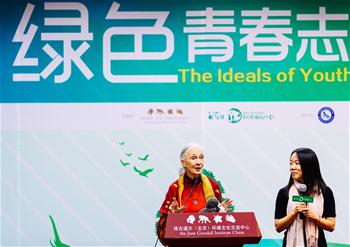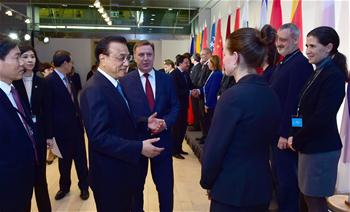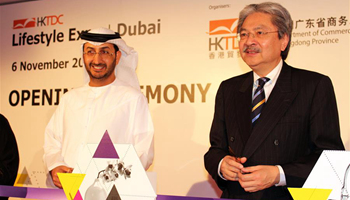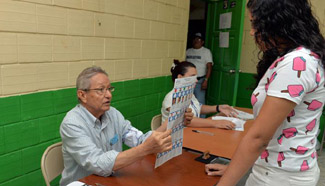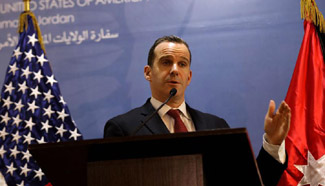By Xinhua writers Yang Chunxue and Yu Fei
BEIJING, Nov. 7 (Xinhua) -- While the rest of us focus on the two Chinese astronauts in space lab Tiangong-2, scientist Liu Liang is watching the time.
It's the time on the cold atom clock that Liu and his team took 10 years to make. Though the cylinder-shaped black object bears no resemblance to an ordinary clock, it is one of the most advanced timepieces ever.
"The clock could be behind the curtains in the space lab," reckons Liu, who is professor and director of the Key Laboratory of Quantum Optics, Shanghai Institute of Optics and Fine Mechanics, Chinese Academy of Sciences.
He expects the astronauts might sometime open the curtains so he could see his masterpiece again.
The clock was sent to space with Tiangong-2 in September, becoming the first ever cold atom clock working in space. "It is so accurate that it should not lose one second in 30 to 300 million years in space," says Liu.
Making such a timepiece is time consuming. Over the past 10 years, Liu has devoted most of his time to the clock. He even spent the Spring Festival, the most important holiday in China, in the laboratory. "I have no time," he says constantly every day.
Time should be something that Liu is expert on, but to Liu, it is the most incomprehensible thing. "We often talk about it -- we ask 'What time is it?' but none of us know what time really is," Liu says.
"Instead of researching the essence of time, we have endeavored to measure time by making this cold atom clock."
But Liu does hope that scientific research will gradually unveil the mystery of time and space. "When did time begin? Is there an origin of space? Is there any structure to time and space," Liu lists the questions.
TIME FOR NEW DISCOVERIES
Unlike ordinary clocks, the cold atom clock is based on atomic physics. And unlike most of atomic clocks, this clock uses more advanced "cold atom" technology, ensuring its ultra precision.
A mechanical watch loses almost one second a day; a quartz watch loses about one second every 10 days; the hydrogen atomic clock loses about one second over millions of years; the cold atom clock exceeds all in accuracy, Liu says.
Scientists attribute its accuracy to the microgravity environment in space as well as the coldness of the atoms the clock uses.
Under microgravity conditions, the cold atoms, pushed by lasers, perform a uniform motion in a straight line. By observing their performance, scientists get more precise atomic clock signal than under the Earth's gravity.
Moreover, the laser cooling technology helps to eliminate the influence of atomic thermal motion on the clock's performance.
"Though molecules and atoms can't be seen in a room, they are actually moving at high-speed," Liu explains.
"We use laser cooling technology to slow down the atoms to a temperature that a refrigerator could never reach, so they nearly stay still," Liu says. "By observing the almost static atoms we make our measurements more precise."
Scientists believe that putting such a clock in space will help set a time standard to synchronize other atomic clocks in space more precisely. "A more accurate clock system in space will benefit us on Earth," Liu says, citing possible substantial improvements in navigation and positioning accuracy.
Scientists say the development of cold atom technology in space could also make many other advances possible, such as deep space navigation and positioning, dark matter probes, and even gravitational wave exploration.
"A lot of research is based on our measurement of time and space. If we could detect subtle changes in time and space, we could make discoveries beyond the range of existing technology," Liu says.
NEVER A SECOND LOST
Liu wears a special watch that never loses a second.
"The watch can receive long wave signals so that it makes an automatic calibration with National Time Service Center every evening," Liu explains.
This detail sheds light on his quest for accuracy in life and work.
"My team members all maintain a high demand for accuracy. We never delay meetings, and we always manage to finish our tasks on schedule, even if it means working all night," Liu says.
Liu recalls the hardship they went through when preparing the prototype of the clock.
"Time was limited, and there was something wrong with the prototype, and we couldn't find the reasons."
They spent days and nights and even the eve of Spring Festival in the lab checking every aspect. They finally solved the problem on the last day of the stipulated date. "It turned out to be a problem with a single piece of magnet," Liu says.
NEVER RESTING
Over the 30 days of the two astronauts living in the space lab, the cold atom clock has been on standby mode.
"That means the main body of the clock stops working, and only some parts are operating," Liu says. This ensures the safety of the astronauts and the accuracy of the clock's data as the microgravity environment could be affected by human activities.
But Liu's team never rests. They use the time to assess the experience from the last phase, and prepare for the next phase as the clock will soon have to work after the astronauts return to earth.
"The clock is operating smoothly so far, but making it more adaptable to working in space still poses challenges," Liu says.
In fact, the cold atom clock experiments in Tiangong-2 are only the first step in Liu's ambition.
He plans to put more atomic clocks on the space station that China is expected to establish around 2020, which will make more experiments possible and ensure a more precise time and frequency system.
That will be a bigger system combining three clocks: a hydrogen clock, a cold atom clock, as well as an optical clock, Liu reveals.
Timepieces have evolved from the sundial of ancient times to the pendulum clock, the quartz clock, and later to the atomic clock, Liu says. He foresees that the future will be dominated by the optical clock or even the nucleus clock.
"Our ultimate goal is to make a clock that will never be a second fast or slow over the life of the universe."




